
Akagera National Park, Rwanda’s only savannah park and the only destination for a wildlife safari trip in Rwanda, is home to the famous African big five (Lion, Leopard, Buffalo, Rhino and Elephant) and many other animals such as giraffes, hyena, antelopes, crocodiles and hippos.
Many travelers visit Akagera national park on non-guided safari tours, exploring the different parts of the vast park on their own. As much as there have not been any incidents of animal attacks and accidents, however with the increasing population of animals and reintroduction of lions and rhinos in Akagera it will not be long before these incidences happen. In this article I share tips on how to explore the park safely.
1. Keep on the drive tracks
Akagera National Park has a good network of drive tracks that allows for easy exploring of the different parts of the park. Tourists are also provided a map of the park showing the different trails/tracks in the park for easy navigation. Sometimes it may be tempting to get off the track and get closer views of an animal. However this is risky as you have no escape route in case you are charged at by a large animal such as an elephant. Going off the track is also illegal and attracts a heavy fine by the authorities if found.
2. Go slow, do not drive beyond 40km/hr
40km/hr is the accepted speed limit in Akagera National Park. Some sections of the tracks are quite smooth but do not be tempted to drive at higher speed because any time an animal could cross the road. Knocking a large animal like an elephant, buffalo, or rhino will be fatal for you. Or you will put the small animals at risk and causing a roadkill attracts a heavy fine by the park if caught.
3. Do not get too close to animals, do not get closer than 10 meters
10 meters is considered the safe distance from an animal, getting closer than that would agitate the animal. This is especially advised for the large dangerous animals such as elephants, rhinos, giraffes and buffaloes, as well as the predators like the lions, leopard, and hyena. However depending on the behavior displayed by the animal you may need to keep as far as possible. Keep farther away from lone elephant bulls and buffaloes that in most cases have been forced out of their herds and are frustrated. They take any chance to vent their anger. You should also not get too close to animals with babies such as elephants, and predators like leopards who are very protective of their babies.
4. Wear nature blending colors. Avoid red
Wear nature blending colors such as the brown and green colors. Avoid bright colors, especially red because it looks like blood to predators like lions that can be attracted to attack. To some other animals and birds, it is a color that signifies danger and will flee away thereby spoiling your experience. Tsetse flies which are present in the southern part of Akagera National Park are also attracted to bright colors and will give you nasty bites.
5. Do not leave the car except in designated areas i.e. camping/picnic grounds
Do not be tempted to leave the car, especially near bushes and thickets. An animal could be larking nearby and pounce you. The biggest threat are the buffaloes which are fond of ambushing from bushes, and the snakes of course of which Akagera national Park has plenty. Only get out of the car from designated cleared areas in camping grounds. But even here you should first scan the nearby environment for animals and snakes on the ground!
6. Do not smoke in the park
Do not be tempted to smoke near bushes because you can start a fire
7. Do not feed the animals
Feeding animals such as monkeys, baboons, elephants can cause them to lose their natural instinct of looking for food and will result to attacking humans when they see foods such as fruits in the car.
8. Keep the car and room doors closed
Keep the doors closed and locked to keep out animals and snakes that could easily creep in and could harm you!
9. Take a park guide for the safari drive
The park provides guides for hire on game drive. The guides know about the wildlife of the park and the best spots to find particular animals. They also know about animal behavior and will know what to do when faced with an agitated animal.
Top animals to be extra careful about
Hippo – number one killer animal in Africa! Good thing they spend the day in water and only come out in the evening when the temperature is cool. Be vigilant when walking around your lodge at night more so if staying near water
Elephant – Do not get too close to a herd with babies, elephants are very protective. Also avoid close encounter with lone bulls, they are frustrated after being chased out of their herds.
Buffalo – Avoid lone buffaloes, these are mostly bulls that have been chased from their herds and are very frustrated and angry and will look for an opportunity to vent their anger.
Rhinos (black rhino) – the black rhinos are now present in the southern area of the park which is largely covered by woodland and forest. The black rhino is known to be more aggressive than the white rhino. Already, one of the experts brought in to train the local management of the park on monitoring the rhinos was killed by a black rhino in Akagera.
Crocodile – huge crocodiles can be seen basking along the shores of lakes and wetlands in Akagera National Park. Avoid getting too close to the shores.
Snakes – Akagera National Park is home to many species of snakes, including the highly venous mabamba family, vipers, cobras, etc… Avoid walking bushes and scan your immediate environment when out of the car.
Tsetse flies – the southern region of the park has tsetse flies and they give a nasty bite. Put on insect repellent and avoid bright colors and keep the car windows up when going through the acacia woodland in the south of the park.
Lions – lions are thought of as the most dangerous animals but on the contrary they do not attack what they are not interested in eating and luckily humans are not on the menu. However keep away from a lioness with cubs, same with all other predators with cubs such as leopards, they are very dangerous during this time!
